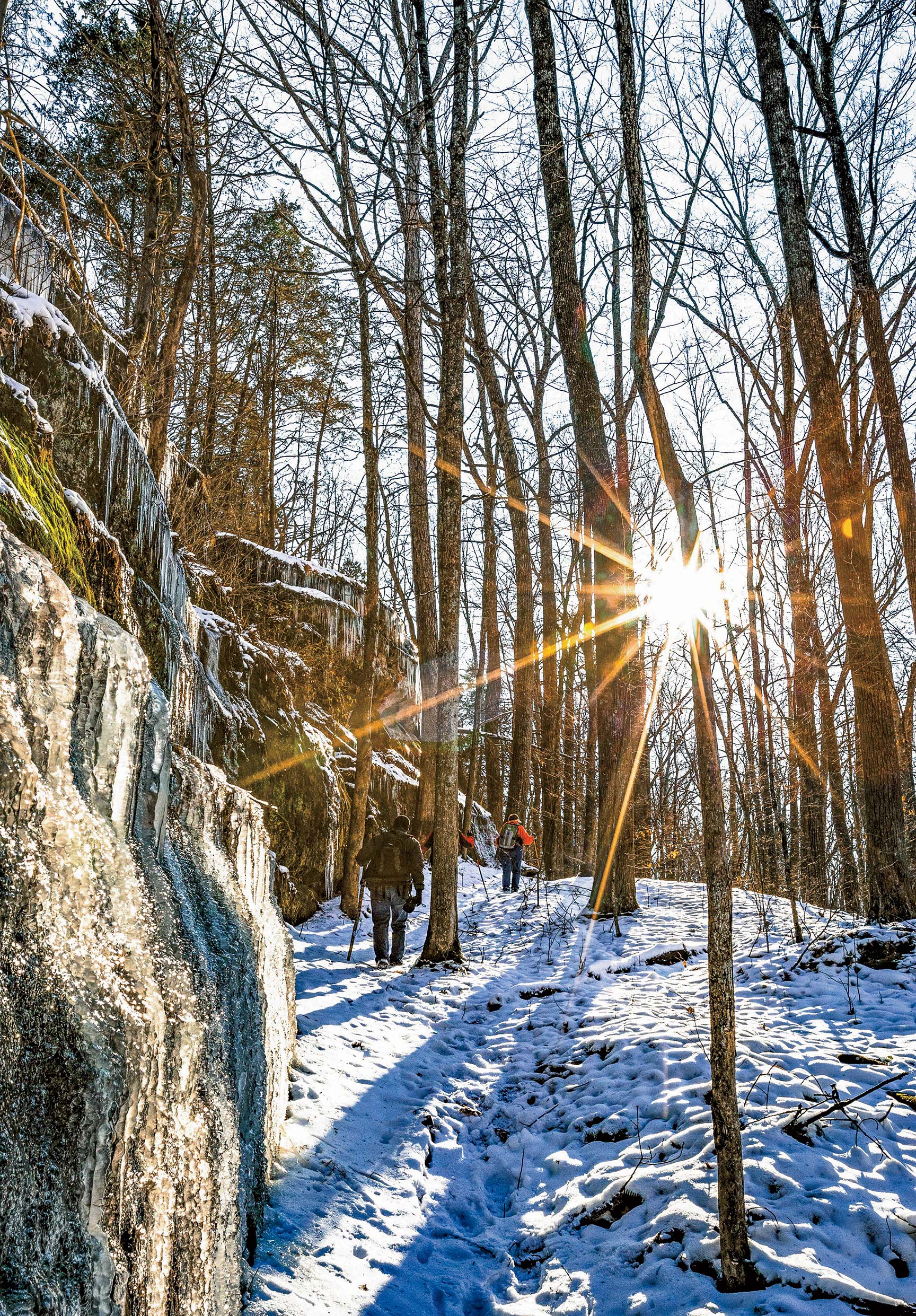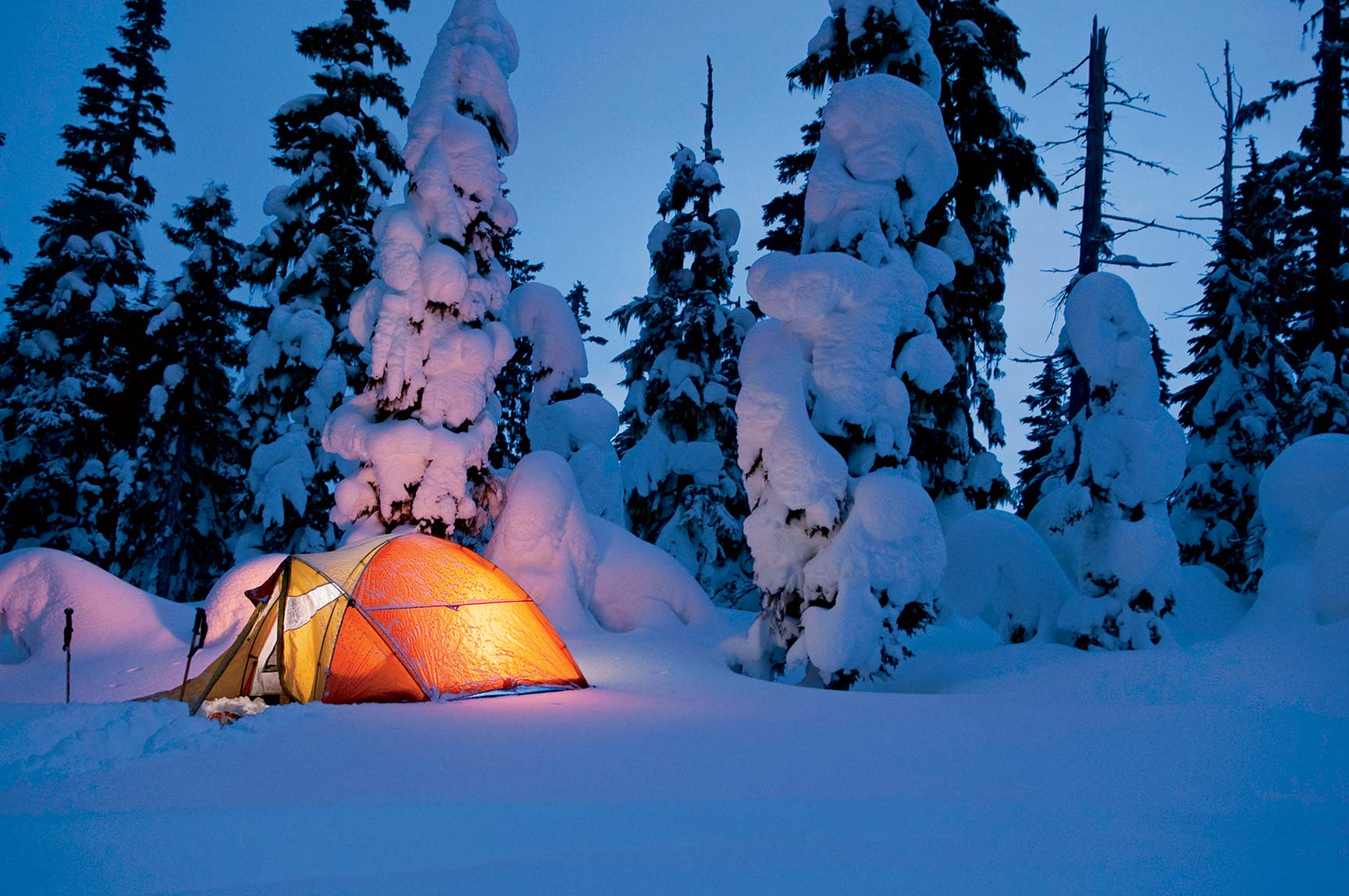The phrase “winter camping” rightly incites an instinctual shiver in most of us. But with the correct gear and some expert tricks, spending the night outdoors from January to March can be, dare we say, downright toasty. Here’s everything you need to know for a fun, not-too-frozen campout under the stars.
Where to Go
● For an overnighter Camp Bullfrog Lake in Willow Springs “gives you such access to all the amenities of the Palos Forest Preserves — whether it’s the trails, mountain biking, or horseback riding,” says Theresa Salus, a regional experiences manager at REI in Chicago. “You can set up your tent, cook over your fire, go hiking, and feel like you are, you know, away.” Also onsite: ice-fishing and cross-country skiing, with equipment rentals and lessons offered at nearby Sagawau Nordic (from $10 a person). Bullfrog Lake includes both primitive (from $21 a night) and RV sites (from $27 a night) as well as nonwinterized and winterized cabins (from $42 a night), depending on your level of comfort in the outdoors.
● For a weekend Mississippi Palisades State Park in Savanna is like a less populated Starved Rock, Salus says. The craggy rock formations and dramatic views will make you wonder if you’re really still in Illinois. Activities include cross-country skiing, ice-fishing, and sledding (BYO equipment for everything). Bundle up, because it’s all tent camping, all the time (from $5 a night), on a first-come, first-served basis in winter.
● For a long weekend Shawnee National Forest in Herod is the only national forest in Illinois. The nearly 300,000 acres at the bottom tip of the state feature year-round camping — from just the basics (from $10 a night) to developed sites with showers and electrical hookups (from $12 a night) — plus hiking among canyons, forests, and natural bridges. At about six hours from downtown Chicago, it “looks nothing like this part of Illinois,” Salus says. Read: It’s a real escape.

What to Bring
● Four-season tent “MSR [from $249] is a well-trusted brand, especially for cold weather extremes, and they’re very well built,” says Richard Eisloeffel, the manager of the Gearhead Outfitters (formerly Uncle Dan’s) Lake View store. “This tent will last you a very long time.”
● Sleeping pad Check out the Nemo Switchback one (from $40)—it’s an accordion-style foam pad (hint: you don’t have to blow this one up) that has a reflective top. “If you think of those emergency blankets that they use in accidents, the idea is that they reflect the heat back at you,” says Eisloeffel. “So it’s that in a sleeping pad.”
● Down sleeping bag The Sea to Summit Ascent Down (from $272) is “well built and very light. It’s something as warm as possible while also as light as possible,” says Eisloeffel. Plus, it’s got a hood to cradle your head.
● Merino wool base layers Eisloeffel recommends Icebreaker and Smartwool clothing specifically, but here it’s really the material that matters more than the maker. “Merino wool is just a very good thermo-regulating moisture-wicking, quick-drying material. If it does get wet, it won’t freeze on your body, like cotton would,” says Eisloeffel. If you’re vegan or allergic to wool, a nice synthetic line is the Capilene series from Patagonia.
● Water jug Most campsites turn off the taps in winter, so you’ll have to haul your own H20. Coghlan’s collapsible jug ($13) is easy to lug around and store when not in use. “It’s great to keep in your car,” says Eisloeffel. “A lot of people think, Because it’s cold, I’m not going to sweat as much and won’t need as much water — but you can still get dehydrated in the cold.”
How to Stay Warm
● Pack multiple sets of layers Make sure you have a base, mid, and outer layer. And have more than one set, Salus says: “When you transition from your day activities to sleep, change into a fresh base layer and a fresh pair of socks to make sure you’re not carrying that moisture into your tent, which keeps you cold.”
● Pack what you’re sleeping in in your sleeping bag “I usually will stuff my thick wool socks, the ones I’m not hiking in all day, into the sleeping bag so I know they’re just there,” says Eisloeffel. He recommends doing that with all your PJs. Bonus: They’ll be a bit warmer.
● Preheat your sleeping bag Both Salus and Eisloeffel recommend boiling water, filling your Nalgene up with it, and putting the bottle in the foot of your bag before you go to sleep.
● Do a pre-bedtime workout Go for a hike or do a few jumping jacks before you change your base layer and slide into your bag. “You’re radiating your own heat,” says Salus, turning yourself into your own furnace.



